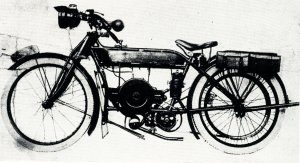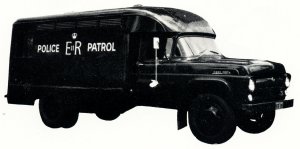Motor Vehicles Branch – 1912 – 1962
– Transport –
Motor Vehicles Branch 1912
The advent of the self-propelled motor vehicle upon the streets of Sydney about the turn of the 19th century, and the replacement of the steam trams by new electric models in 1899 were the initial signs to the populace of Sydney that the modern era had indeed begun.
FIRST POLICE MOTOR VEHICLE
The first motor acquired by the Police Department dates back to 1912, when a single seater “Sunbeam” roadster was transferred from the Premier’s Department for the exclusive of the Inspector-General. This vehicle was freely used within the Department, travelling 250,000 miles throughout New South Wales before being eventually sold.
INTRODUCTION OF MOTOR PATROLS
 |
|
First Police motor cycle, 1914 |
In 1913 there was much congestion in the streets of Sydney, occasioned by the great preponderance of horse drawn vehicles, electric trams, and slowly increasing motor vehicles. To relieve the congestion the Inspector-General of the day introduced a motor cycle patrol to carry out specific traffic duties. The first departmental solo motor cycle was a horizontal twin cylinder 2.3/4 h.p. “Douglas”, capable of a top speed of 50 miles an hour. A second machine purchased soon afterwards was an “A.J.S.” solo special. In February, 1915, the first motor patrol unit in Australia came into use – the patrol was built on a second hand “Renault” chassis and was the prototype of many later improved models. By January, 1920, the departmental fleet of motor vehicles had increased to six four-wheeled vehicles and 29 motor cycles of varying makes.
 |
|
First motor patrol van, 1915 |
ADVENT OF WIRELESS CARS
In 1924 it was decided by the Inspector-General to introduce a Wireless Car to patrol the streets of Sydney and neighbouring suburbs. The first car was a 1925 “Buick” tourer, and the first wireless operator was Mr. W. E. Salmon. In 1927 a “Studebaker” tourer was placed in service and the two patrols were known as the “East” and “West” wireless patrols. In 1931 the cars were fitted with two-way Morse transmission, and in 1937 two-way radio was introduced. During 1935 two additional wireless cars were introduced, known as the “North” and “Far West” patrols. On 13th October, 1958, the “North West” and “South West” cars commenced patrol duties..
 |
|
First P.D. car |
INAUGURATION OF PUBLIC SAFETY BUREAU
In 1925 a “Studebaker” tourer commenced Public Safety Bureau duties, and in a short space of time was bringing 50 offenders a week before the Traffic Courts. One of the main essentials of a car of that era was that it could attain a speed of at least 60 miles an hour in safety. This safety precaution has been kept to a critical standard even to this day.
ESTABLISHMENT OF MOTOR VEHICLES BRANCH
Until 1927 all Police vehicles were under the control of the Superintendent of Traffic, but in that year, as the fleet of Police motor vehicles had increased to 143, a new branch, the Motor Vehicles Branch, was formed on the 12th December, 1927. The familiar vehicles of that year were “Armstrong Siddley’s”, “Austin’s” and “Morris Cowley” tourers. These were replaced in 1933 by large “Vauxhall” tourers, but today the most familiar Police cars are “Holden’s”, and “Fords”.
POLICE SERIAL NUMBERS
In January, 1931, serial numbers or numbers identifying each vehicle were issued to all Police Vehicles. Identification previously had been restricted to a P.D. plate, which was transferred from car to car. Traffic patrol duties were originally carried out by solo motor cycles, but owing to the treacherous nature of Sydney’s streets, caused by tram lines and wooden road blocks, solo cycles were replaced by motor cycle outfits. In 1938 solo cycles were again utilised by the Public Safety Bureau, but owing to a high Police accident rate were again abandoned. In 1946 a further trial proved successful, and at the end of 1947 a fleet of high powered solo cycles were permanently attached to the Public Safety Bureau for traffic patrols.
NEW MOTORISED UNITS
In the 1960’s, a number of specially equipped motor vehicles were added to the Departments fleet. These included specialised units used by the Police Rescue Squad, Diving Squad, Scientific Bureau and Flood Rescue Squad. Ancillary vehicles included a mobile canteen, a high powered Police omnibus and an emergency lighting plant capable of supplying power at the scene of any major disaster. The Department also operated a tow truck which was used by the maintenance staff on breakdowns. This vehicle was equipped with “pushers” to remove illegally parked vehicles from the route of any major procession.
A special radar car kept a vigilant eye on speeding motorists, and modern prison vans conveyed prisoners from the State Penitentiaries to the various Courts. Specially equipped vehicles were used by the Radio Communications Centre at Sydney and Waratah. These vehicles were so designed that they could become mobile wireless stations in times of emergency and service vans during routine events. Special vehicles were also used by the School Lecturing Section to convey personal to metropolitan schools where lectures were given to the younger generation on road safety. Large trucks were also available to convey barriers when required for processions or for fencing off buildings damaged by fire. In addition to operating and controlling the abovementioned vehicles the Branch was also responsible for the maintenance of all Police launches and bicycles in use by the Department.
 |
|
Police patrol van, 1960’s |
POLICE INSTRUCTIONAL MOTOR SCHOOLS
A school for training motor cyclists in the art of solo riding had been operated by the Motor Vehicles Branch since the 3rd, September, 1956. This school proved invaluable, and was the centre from which high speed solo cyclists gained their initial experience. In an endeavour to further increase the efficiency of all Police drivers a Police Driving School was established at St. Ives.
POLICE MOBILITY
The Motor Vehicles Branch in 1962, controlled, on behalf of the Commissioner of Police, a fleet of 1,280 vehicles consisting of 776 four-wheeled vehicles and 504 motor cycles. During 1961 these vehicles travelled 20,939,705 miles in the enforcement of law and order and the preservation of life and property through the entire State.
1950
The Minister for Transport, Mr. Sheahan, has advised ( in October ) that arrangements are in hand for the purchase of sirens to be fitted to all special traffic patrol units used throughout the state of NSW. It is anticipated that all vehicle will be so equipped within approximately two months.